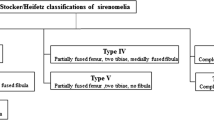Abstract.
Sirenomelia, also called the mermaid syndrome is a severe malformation involving multiple organs and characterized by partially or completely developed lower extremities fused by the skin. The birth of a “mermaid” is very rare (1.2–4.2 cases for 100,000 births); most are stillborn, or die at or shortly after birth. The case of a living female neonate with dipodic simelia (fusion of well-developed legs) is presented. No prenatal diagnosis was made and the newborn had an uneventful neonatal course following Cesarean section delivery. The complex and striking malformation was obvious at birth and further evaluation revealed very poorly functioning kidneys, associated with abnormal anorectum, urogenital tract, and external genitalia, as well as a pelvic malformation. Supportive care was applied because of the poor prognosis and the child died at 7 weeks of age, due to renal failure.



Similar content being viewed by others
References
Stocker JT, Heifetz SA (1987) Sirenomelia, a morphological study of 33 cases and review of the literature. Perspect Pediatr Pathol 10:7–50
Duhamel B (1966) L’ectrourie proprement dite. In: Duhamel B (eds) Morphogenèse pathologique, Paris, Masson, pp 165–172
Heyl W, Funk A, Grün M et al. (1998) Sirenomelie: pränatale diagnose und klinische Konsequenz einer seltenen Fehlbildung. Z Geburtsh Neonatol 202:121–126
Källen B et al. (1992) The cyclops and the mermaid: an epidemiological study of two types of rare malformation. J Med Genet 29:30–35
Lorenzo M di, Brandt ML, Veilleux A (1991) Sirenomelia in an identical twin: a case report. J Pediatr Surg 26:1334–1336
Langer B et al. (1996) Sirenomelia and Situs inversus: case report and review of the Literature. Fetal Diagn Ther 11:79–84
Murphy JJ, Fraser GC, Blair GK (1992) Sirenomelia: case of the surviving mermaid. J Pediatr Surg 27:1265–1268
Savader SJ, Savader BL, Clark RA (1989) Sirenomelia without Potter syndrome: MR characteristics. J Comput Assist Tomogr 13:689–691
Clarke LA, Stringer DA, Fraser GC et al. (1993) Long-term survival of an infant with sirenomelia. Am J Med Genet 45:292–296
Author information
Authors and Affiliations
Corresponding author
Rights and permissions
About this article
Cite this article
Lutz, N., Meyrat, B.J., Guignard, JP. et al. Mermaid syndrome: virtually no hope for survival. Ped Surgery Int 20, 559–561 (2004). https://doi.org/10.1007/s00383-003-0992-7
Accepted:
Published:
Issue Date:
DOI: https://doi.org/10.1007/s00383-003-0992-7




